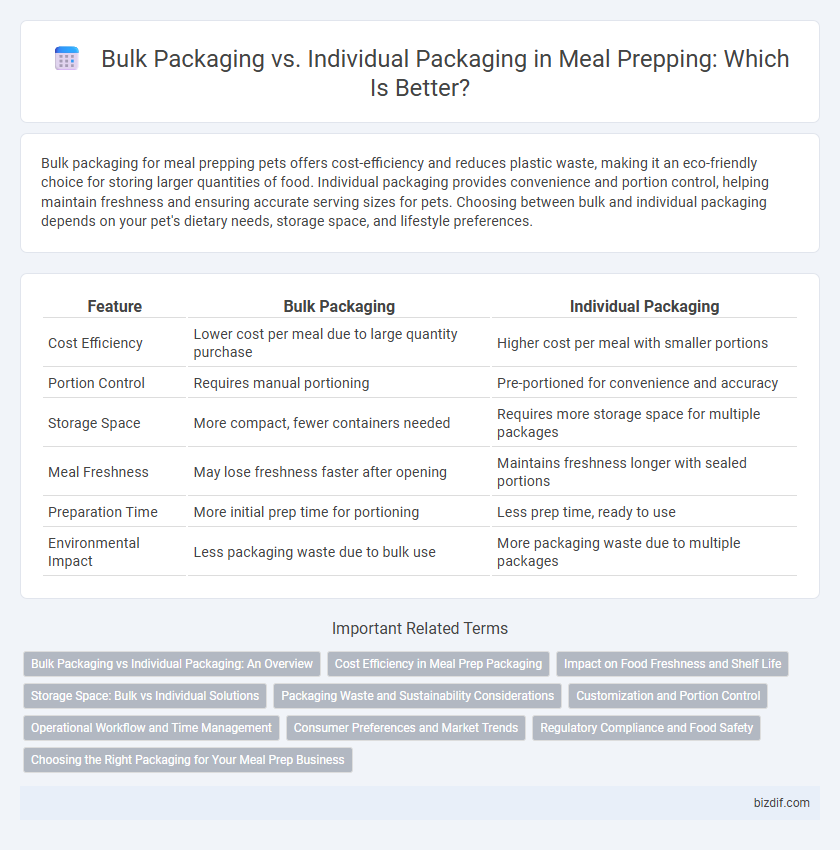Bulk packaging for meal prepping pets offers cost-efficiency and reduces plastic waste, making it an eco-friendly choice for storing larger quantities of food. Individual packaging provides convenience and portion control, helping maintain freshness and ensuring accurate serving sizes for pets. Choosing between bulk and individual packaging depends on your pet's dietary needs, storage space, and lifestyle preferences.
Table of Comparison
| Feature | Bulk Packaging | Individual Packaging |
|---|---|---|
| Cost Efficiency | Lower cost per meal due to large quantity purchase | Higher cost per meal with smaller portions |
| Portion Control | Requires manual portioning | Pre-portioned for convenience and accuracy |
| Storage Space | More compact, fewer containers needed | Requires more storage space for multiple packages |
| Meal Freshness | May lose freshness faster after opening | Maintains freshness longer with sealed portions |
| Preparation Time | More initial prep time for portioning | Less prep time, ready to use |
| Environmental Impact | Less packaging waste due to bulk use | More packaging waste due to multiple packages |
Bulk Packaging vs Individual Packaging: An Overview
Bulk packaging in meal prepping minimizes plastic waste and reduces packaging costs, making it ideal for families or individuals who consume larger portions over multiple meals. Individual packaging offers convenience and portion control, allowing for easy grab-and-go meals and reducing food spoilage by keeping servings separate. Choosing between bulk and individual packaging depends on lifestyle, storage capacity, and meal consumption patterns.
Cost Efficiency in Meal Prep Packaging
Bulk packaging in meal prepping significantly reduces per-unit costs by minimizing material usage and labor compared to individual packaging. Purchasing ingredients and containers in bulk allows meal preppers to leverage economies of scale, lowering overall expenses. This cost efficiency is especially beneficial for large-scale meal preparation, where packaging multiple servings together maximizes resource utilization and reduces waste.
Impact on Food Freshness and Shelf Life
Bulk packaging preserves food freshness by minimizing exposure to air and moisture, significantly extending shelf life compared to individual packaging. However, individual packaging provides better portion control and reduces the risk of cross-contamination, although it may lead to quicker spoilage once opened. Optimizing packaging choice depends on balancing freshness preservation with convenience and consumption patterns.
Storage Space: Bulk vs Individual Solutions
Bulk packaging maximizes storage efficiency by consolidating ingredients or meals into larger containers, reducing the overall space occupied in refrigerators or freezers. Individual packaging, while providing portion control and convenience, tends to consume more storage space due to multiple smaller containers that must be accommodated. Choosing bulk packaging is ideal for those with limited storage, while individual solutions suit users prioritizing meal variety and grab-and-go accessibility.
Packaging Waste and Sustainability Considerations
Bulk packaging significantly reduces packaging waste by minimizing the use of materials compared to individual packaging, making it a more sustainable option for meal prepping. Individual packaging, while convenient for portion control, generates higher volumes of single-use plastics and other non-recyclable materials, contributing to environmental pollution. Choosing reusable or compostable bulk containers further enhances sustainability by lowering landfill impact and conserving resources.
Customization and Portion Control
Bulk packaging offers greater flexibility in customizing meals according to dietary preferences and allows for easier adjustment of portion sizes based on individual needs. Individual packaging enhances portion control by providing pre-measured servings that reduce the risk of overeating and simplify meal planning. Combining both methods can optimize meal prep efficiency while maintaining precise nutrition management.
Operational Workflow and Time Management
Bulk packaging streamlines the operational workflow by reducing repetitive tasks and minimizing packaging materials, leading to faster assembly and lower labor costs in meal prepping. Individual packaging offers precise portion control and easier distribution but demands more time and coordination, potentially slowing down production processes. Efficient time management balances the speed of bulk prep with the convenience and customization of individual portions to optimize overall workflow and resource allocation.
Consumer Preferences and Market Trends
Consumer preferences in meal prepping increasingly favor bulk packaging for its cost-effectiveness and reduced environmental impact, appealing to budget-conscious and eco-aware individuals. Market trends highlight a growing demand for bulk packaging solutions that maintain freshness and convenience, supporting larger portion control and longer storage life. However, individual packaging retains popularity among busy consumers prioritizing portion accuracy and on-the-go convenience, driving innovation in resealable, microwave-safe packaging options.
Regulatory Compliance and Food Safety
Bulk packaging in meal prepping often requires stringent adherence to regulatory standards such as FDA's Food Safety Modernization Act (FSMA) to prevent cross-contamination and ensure traceability. Individual packaging offers enhanced control over portion sizes and reduces the risk of contamination, aligning with Hazard Analysis and Critical Control Points (HACCP) principles. Ensuring compliance with labeling regulations, including allergen declarations and expiration dates, is critical regardless of the packaging method selected.
Choosing the Right Packaging for Your Meal Prep Business
Selecting the right packaging for your meal prep business hinges on considering customer convenience and product freshness. Bulk packaging reduces material costs and environmental waste, making it ideal for family-sized portions or wholesale clients. Individual packaging enhances portability and portion control, attracting busy consumers seeking quick, single-serve meals.
Bulk packaging vs individual packaging Infographic

 bizdif.com
bizdif.com